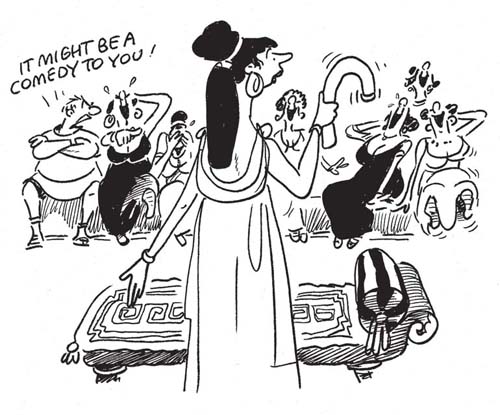
Male sexual organs are depicted in Moche pottery, showing testicles and penis, with the foreskin folded back showing the gland. These were drunk from, thus converting them into a sort of instrument of artificial fellatio.
One Moche pot shows a male anally penetrating a female asleep in bed between her parents.
In Moche pottery, 95 percent of the sex depicted seems to be anal, though heterosexual; the fellatio is all heterosexual, but there is no cunnilingus. Whether engaged in vaginal, anal or oral intercourse, the male face always remains totally impassive.
Musical instruments can often be seen in an erotic context, especially in Graeco-Roman figurines where the man’s phallus is either part of the musical instrument or used for playing it.
The Romans had ‘willy pots’ — the Roman site of Stonea Grange in Britain produced a pot with no less than 21 phalli shown on it. In fact the Romans were obsessed with phalli — little boys wore them round the neck, there were phalli hung up in Pompeian houses with bells on them and wings; they had phalli outside the doors, on street corners, etc. Many other ancient cultures, such as the Egyptian, also employed erotic amulets with huge phalli.
The House of the Vettii at Pompeii has a fountain in the form of an ithyphallic figure, with its phallus serving as a waterspout; and a painting of Priapus weighing his enormous penis. Other erotic scenes are painted in a small room by the kitchen.
The ancient Greek visual arts show that they admired a thin, short penis, terminating in a long pointed foreskin; the small penis goes with a scrotum of normal size, while the erect penis is depicted with normal proportions.

31
Greek artists often emphasised the small pointed penis of Herakles as opposed to the stubby and circumcised genitals of barbarian attendants. Aristotle’s explanation for this predilection for small genitals was that the small penis is more fertile than the large one, because the seed has a shorter distance to travel through it, and so doesn’t cool off so much.
The Greek taste for dainty, pointed penises led to a custom of infibulation — to prevent the foreskin from becoming damaged while exercising in the nude, young athletes tied it down over the glans with a leather string, sometimes tucking up the penis with the same string as well. The knot was called ‘kynodesme’ or’dog tie’, and functioned something like a jock strap.
One Greek vase shows a musician, whose hands are fully occupied with the double pipe, having a spontaneous ejaculation, while a bewildered bee dodges the bombardment.
32
There is also an ancient Greek depiction of a hairy satyr masturbating while pushing a penis-substitute into his own anus.
Egypt’s king Menaphta, who defeated the Libyans in 1300 BC, collected the penises of his slain enemies as battle trophies.
During the summer of 415 BC, Athens was shaken by a scandal. A group of conspirators, moving through the city under cover of night, mutilated the ‘herms’, statues of the god Hermes — these statues were plain rectangular pillars, with a head and erect male genitals. Almost all of them were castrated — a highly symbolic crime. There were hundreds of them, in private and public places. It was never discovered who did the terrible deed (32).
In ancient Greek comedy there are a number of jokes about the use, by women of a respectable class, of self-satisfiers or dildos, made of leather. They were known as olisboi, derived from a verb meaning to glide or slip. A few vases show naked women using them in fairly fantastic ways — they could be prostitutes, or simply imaginary scenes.
The island of Lesbos, to the ancient Greeks, was not associated with female homoerotism but with fellatio — the verbs ‘lesbiazo’ and ‘lesbizo’ refer to that practice. The ancient Greek word for ‘lesbian woman’ in our sense was ‘tribas’, from a root meaning ‘rub’.
In an old Greek comedy, one woman suggests that the dildo resembles the real organ as the moon resembles the sun it looks the same but lacks heat (33).

33